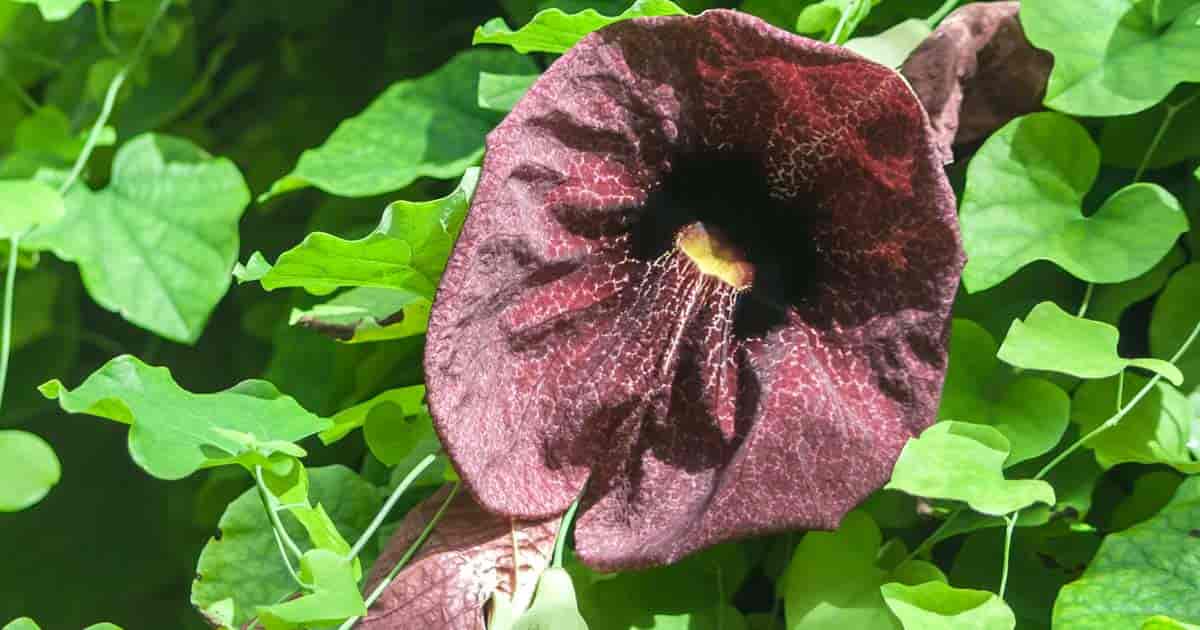
The Dutchman’s Pipe, scientifically known as Aristolochia, is a captivating and unique plant that has intrigued botanists and garden enthusiasts alike for centuries. With its distinctive pipe-shaped flowers and impressive growth habit, this plant has earned a special place in the world of flora.
In this article, we will uncover 12 fascinating facts about the Dutchman’s Pipe that will deepen your appreciation for this incredible plant. From its diverse species to its historical uses, you’ll gain insight into the many facets of this remarkable plant. So, prepare to be amazed as we delve into the captivating world of Dutchman’s Pipe!
Key Takeaways:
- Dutchman’s Pipe is a fascinating plant native to North America with unique pipe-shaped flowers, attracting flies and hosting butterflies. It’s easy to care for and a conversation starter in any garden.
- Dutchman’s Pipe has a rich history of human use, inspiring art and traditional medicine. Its captivating appearance and ecological relationships make it a must-have for nature enthusiasts.
The Dutchman’s Pipe is a unique and fascinating plant.
The Dutchman’s Pipe, also known as Aristolochia, is a captivating flowering plant that belongs to the Aristolochiaceae family. Its name comes from the peculiar shape of its flowers, which resemble a tobacco pipe.
The Dutchman’s Pipe is native to North America.
This remarkable plant can be found throughout North America, from Canada to Mexico. It thrives in moist forests, swamps, and along riverbanks, where it can climb up trees and shrubs.
The Dutchman’s Pipe has unique, pipe-shaped flowers.
The most distinctive feature of the Dutchman’s Pipe is its flowers. They are shaped like a curved pipe, with a long tube and a flared, three-lobed lip. The flowers are often greenish-yellow or brownish-purple and have an intricate pattern.
The Dutchman’s Pipe is pollinated by flies.
The Dutchman’s Pipe has a fascinating reproductive strategy. It attracts flies with its pungent odor and traps them inside the flower, where they become covered in pollen. When the fly escapes, it carries the pollen to another flower, ensuring cross-pollination.
The Dutchman’s Pipe is a host plant for Pipevine Swallowtail butterflies.
One of the most interesting relationships involving the Dutchman’s Pipe is its connection with the Pipevine Swallowtail butterfly. The butterfly lays its eggs on the plant, and when the caterpillars hatch, they feed exclusively on the Dutchman’s Pipe leaves.
The Dutchman’s Pipe has medicinal properties.
The Dutchman’s Pipe has been used in traditional medicine for centuries. It has been believed to have various healing properties, including treating digestive issues, reducing inflammation, and even alleviating respiratory problems.
The Dutchman’s Pipe has a long history of human use.
The use of the Dutchman’s Pipe can be traced back to Indigenous cultures, who utilized various parts of the plant for medicinal and ceremonial purposes. Its unique appearance and cultural significance have also made it a popular choice in landscape design.
The Dutchman’s Pipe is a fast-growing vine.
If you’re looking for a fast-growing climber, the Dutchman’s Pipe won’t disappoint. With its vigorous growth habit, it can quickly cover arbors, fences, and trellises, adding a touch of elegance to any garden or landscape.
The Dutchman’s Pipe attracts unique and vibrant wildlife.
The presence of Dutchman’s Pipe in a garden or natural habitat can attract a variety of interesting wildlife. In addition to the Pipevine Swallowtail butterfly, the flowers also draw in bees, hummingbirds, and other nectar-loving insects.
The Dutchman’s Pipe is a hardy and low-maintenance plant.
One of the great advantages of growing Dutchman’s Pipe is that it is relatively easy to care for. It can tolerate a wide range of soil conditions and is resistant to most pests and diseases. Once established, it requires minimal maintenance.
The Dutchman’s Pipe has inspired artistic creations.
The unique and captivating appearance of the Dutchman’s Pipe has inspired artists and designers. Its distinct shape and coloration have been featured in various forms of art, including paintings, sculptures, and even jewelry.
The Dutchman’s Pipe is a conversation starter.
Having the Dutchman’s Pipe in your garden is bound to spark conversations and intrigue your guests. Its unusual flowers and interesting ecological relationships make it a fascinating and memorable plant to have in any landscape.
Overall, the Dutchman’s Pipe is a truly captivating plant with its unique flowers, intriguing ecological relationships, and rich history of human use. Whether you’re a gardening enthusiast or simply appreciate the wonders of nature, the Dutchman’s Pipe is sure to capture your attention and spark your curiosity.
Conclusion
In conclusion, Dutchman’s Pipe is a fascinating plant with numerous captivating facts. From its unique flower shape to its role as a host plant for butterflies, the Dutchman’s Pipe is sure to grab your attention. Whether you are an avid gardener or simply appreciate the beauty of nature, this plant is a must-have in any garden. With its ability to attract pollinators and its rich history in traditional medicine, the Dutchman’s Pipe offers both aesthetic and practical benefits. So, why not add this remarkable plant to your collection? Start exploring the world of Dutchman’s Pipe and enjoy its extraordinary features.
FAQs
Q: What is the origin of the Dutchman’s Pipe?
A: The Dutchman’s Pipe is native to North America, particularly in the eastern and central parts of the United States.
Q: What is the significance of its unique flower shape?
A: The Dutchman’s Pipe gets its name from the resemblance of its flowers to the pipes commonly used in the Netherlands. This distinct shape serves as a natural adaptation to attract specific pollinators like butterflies.
Q: How tall does the Dutchman’s Pipe grow?
A: Depending on the variety, the Dutchman’s Pipe can grow anywhere from 10 to 40 feet in height.
Q: Can the Dutchman’s Pipe be grown in containers?
A: Yes, the Dutchman’s Pipe can be grown in containers, provided that they have enough room for the plant to thrive and proper support for its climbing tendencies.
Q: Is the Dutchman’s Pipe invasive?
A: Some varieties of the Dutchman’s Pipe can be considered invasive in certain regions. It is important to check with local gardening authorities to determine if a specific variety is suitable for your area.
Q: What are the medicinal uses of the Dutchman’s Pipe?
A: The Dutchman’s Pipe has a long history of use in traditional medicine. It has been used to treat various ailments such as respiratory issues, skin infections, and even as a natural insect repellent.
Dutchman's Pipe is just one of many fascinating plants waiting for you to explore. If you enjoyed learning about this unique vine, why not discover the captivating beauty of Black-Eyed Susan Vine? Native plants like Compass Plant also offer a wealth of interesting facts and ecological importance. Don't forget about the critical role pollinators play in our ecosystems – dive into some fun facts about these tiny but mighty creatures!
Was this page helpful?
Our commitment to delivering trustworthy and engaging content is at the heart of what we do. Each fact on our site is contributed by real users like you, bringing a wealth of diverse insights and information. To ensure the highest standards of accuracy and reliability, our dedicated editors meticulously review each submission. This process guarantees that the facts we share are not only fascinating but also credible. Trust in our commitment to quality and authenticity as you explore and learn with us.


